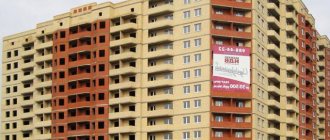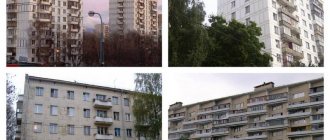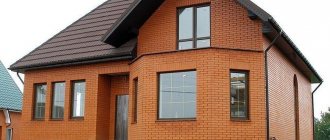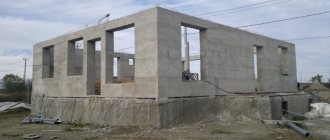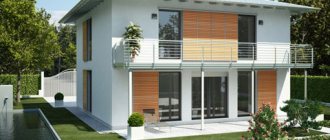Over its centuries-old history, humanity has learned to build houses from a variety of materials. Today, solid buildings made of reinforced concrete are considered one of the most durable structures. This construction technology appeared back in the 60s, when the Frenchman Joseph Monier discovered reinforced concrete absolutely by accident when he was building concrete beds using reinforcement on a suburban site. Let's take a closer look at what a monolith is. What are the advantages and disadvantages of this concrete pouring technology?
Monolithic house: pros, cons
A monolithic house is a solid cast structure. When constructing its load-bearing elements, no blocks, panels, or bricks are used, so there are no masonry joints. At the locations of the frame and ceilings, formwork is installed into which concrete is poured. If we are talking about load-bearing structures, they are additionally reinforced. The reinforcement bars are placed inside the formwork.
Advantages of building monolithic houses:
- speed of construction - even a multi-storey building with an impressive area can be built in 1-2 years, and a cottage in just 2-3 months, including the construction of the foundation;
- extensive architectural possibilities - thanks to modern formwork, elements of any complexity, size and shape can be poured;
- saving costs on foundation construction - in monolithic structures, the load is distributed evenly across all load-bearing structures, so a lightweight foundation can be used;
- relatively light weight of monolithic structures - the technology is suitable even for construction in areas with heaving or unstable soils; if necessary, piles are installed under the foundation;
- simple redevelopment - during operation, the property can be changed for certain tasks, for example, dividing premises into separate rooms or, conversely, combining them, without significantly reducing the load-bearing characteristics of structures:
- long service life - more than 150 years, walls without seams are less damaged by the environment;
- high strength and stability - monolithic houses are suitable for regions with high seismic activity and can withstand earthquakes up to magnitude 8;
- increase in usable area - by 10-15% compared to the use of other construction technologies;
- minimal shrinkage - takes no more than 1 month, after which you can immediately lay utility lines, install windows, doors, carry out repairs and put the house into operation;
- savings on paying for building materials and construction work - a monolithic house is cheaper than a block or brick one, sometimes the difference is up to 30% of the budget without loss of operational characteristics of the property;
- savings in interior and exterior finishing - the walls are initially smooth and even, so they do not require additional leveling.
It is important to know!
Monolithic houses are characterized by increased safety. For example, if a heating or water supply pipe breaks on the second floor of a house, water will not be able to immediately flow down due to the lack of seams in the ceilings. This allows you to localize the accident for a certain time and reduce the risk of damage to neighbors if we are talking about an apartment building.
Disadvantages of monolithic construction:
- The disadvantages of monolithic construction include the impossibility of performing work in bad weather conditions. For example, with excess air humidity, concrete can take a long time to dry and become damp in certain areas. If a house is built at a temperature below +5 degrees, then the solution is heated with industrial heaters or frost-resistant additives are added to it.
- It is difficult to make grooves in solid reinforced concrete for hidden installation of utility lines, so their location is provided for at the project development stage. Standard monolithic walls require additional insulation. But you can also increase the level of thermal insulation by adding expanded clay to the concrete solution
Cost difference
Typically, a customer is interested in two aspects of a product: cost and quality. Each type is good in its own way, the main thing is to choose it correctly for the conditions in which the buyer will live.
Panel housing is cheaper than monolithic housing. So, in Moscow 1 sq. m of apartment in a monolithic structure costs 200,000 rubles, and in a panel building - 120,000 rubles. Since the technologies for building housing from blocks and panels are similar, their cost is approximately the same.
However, considering that the panels are attached to each other using iron parts, and the blocks - using concrete mortar, an apartment in a panel house may be slightly more expensive than an apartment in a block house.
The difference between a monolithic and panel house
Both monolithic and panel houses are made of concrete. But in the first case, load-bearing structures, walls and ceilings are filled with concrete using formwork directly on the site, and in the second, the structure is assembled from ready-made elements. The minimum number of seams increases not only the strength of the structure, but also its thermal and sound insulation parameters.
Panel houses are mainly built according to standard designs. It is usually impractical to manufacture individual elements of unusual shapes or sizes in a factory. The use of formwork allows you to build houses in any architectural style. With its help, you can easily fill columns or arches, which, thanks to the reinforcement, can easily withstand any load.
Recommendations
To construct a building, you always have to touch on different areas of construction. The following will help the reader create a complete and high-quality home:
- a clear understanding of where to start building a house. Laying the foundation is the most important procedure; the durability and strength of the structure depends on the quality of its implementation;
- If you made a mistake with the foundation or there is a desire to complete the floor, you will have to strengthen the foundation. There is a relatively simple way to raise a house using jacks. The method will help lay the right foundation for the house;
- ceilings for a house made of foam blocks is a complex procedure, since the walls have a low load-bearing capacity. Concrete slabs and other heavy floors are undesirable materials;
- At the final stage of construction, it is important to select types of exterior finishing for the house that will create additional protection from the destructive influence of the environment and improve the appearance.
What is better, a monolithic house or a brick one?
Before the advent of monolithic house-building technology, brick houses were always considered the warmest and most reliable. You can build a building with any layout from brick. But it also has its limits. Therefore, for houses above 2-3 floors, the use of brickwork is irrational.
A monolithic private house is not inferior to a brick house in terms of performance characteristics. At the same time, it is more reliable and durable. The construction of monolithic walls will take 20% less time and will reduce the amount of required labor resources, which generally reduces the cost of construction.
Monolith VS brick
1. Brick houses are built by hand and require serious labor costs, and therefore time. Therefore, construction with brick takes longer than the “casting” of a monolithic structure.
2. The cost of housing in brick houses is higher than in monolithic ones. The price is explained by the use of manual labor, the cost of materials, and the permissible height of the object under construction. The lower the number of floors of the building, the fewer apartments the developer will sell, which will also affect the price. If houses up to a maximum of 18 floors are built from brick, then monolithic structures make it possible to “grow” skyscrapers. For example, the tallest building in St. Petersburg, Lakhta Center, was built using monolithic technology. Its height is 462 m.
3. A brick house is significantly heavier, so it shrinks more, which will complicate repair work and add problems to the owners.
4. The walls in the apartments of monolithic houses will be smoother, and repairs will require less finishing materials and time.
5. The brick will “eat” part of the interior space of the apartment. The thickness of the walls of brick houses is from 52 cm, and in monolithic ones - 16-18 cm. The difference, especially in small apartments, is significant.
6. Audibility in monolithic houses is higher than in brick ones, and thermal insulation, on the contrary, is lower. True, the last factor depends more on how conscientiously the developer approaches the insulation of the walls.
Types of monolithic houses:
- solid monolithic;
- monolithic brick house;
- monolithic frame house.
Monolithic frame house: features and advantages
Monolithic frame houses combine the strength of the monolith and the high thermal insulation characteristics of the materials used in frame house construction.
The technology and stages of construction of such buildings are somewhat different:
- Construction of the foundation. A monolithic slab is poured or a ready-made reinforced concrete product is used.
- Construction of load-bearing structures. They are poured with concrete after installing the formwork and reinforcing elements. The result is a solid concrete frame.
- Installation of internal walls and partitions. If the elements are not part of the supporting structure, they are made of foamed concrete or multi-layer wall panels.
A monolithic frame house retains high reliability and resistance to seismic influences. But the possibility of redevelopment of premises is significantly simplified and the options for finishing finishing work are expanded. This technology expands the list of architectural features of cottages. For example, arches, bay windows and panoramic glazing are often used.
Monolithic brick house
A feature of monolithic brick houses is the ability to fill the space between load-bearing cast elements with brickwork.
Because of this, the technology for performing the work changes a little:
- The foundation and formwork of the load-bearing elements are being poured.
- Builders manually lay brick walls and partitions.
- Finishing work is carried out comprehensively after the concrete has completely hardened and the brickwork has settled.
Construction of a monolithic brick house allows you to reduce the cost of renting special equipment. In this case, the building receives all the advantages of a brick house, such as increased thermal insulation or ease of redevelopment.
Reviews from residents
When looking for a type of housing, it is important to hear reviews about it - this will make it easier to navigate the choice of building.
Reviews of monolith buildings
I have been living in a monolithic building for several years now and am very pleased with the choice. In winter it’s warm, turn off all batteries. Audibility is moderate.
Svetlana
A little over a year ago we purchased an apartment in a monolith. We are happy with the temperature: in the frost -40 in the apartment the temperature did not drop below +24 degrees. But there are problems with sound insulation: recently the neighbors celebrated a holiday, and in our apartment it was heard as if we were holding the event ourselves.
Oksana
I live in a monolithic frame building. Satisfied with almost everything, only problems with sound insulation. Since the neighbors are doing renovations and families with small children live in the house, it’s impossible to be quiet.
Andrey
Reviews about buildings made of blocks
We have been living in a block house for 5-6 years. It’s warm, and you can hardly hear any sounds behind the wall. If they do, it’s only in the bathroom because of the riser or because the neighbors have a through socket. Very pleased with the choice.
Tatiana
I recently moved into a block house. I am pleased with the quality of the construction, as well as the sound insulation. You can’t hear the neighbors on the side at all, and those on top only when you turn on the washing machine. Overall, a good impression of block buildings.
Sergey
Reviews of housing made from panels
We recently moved into a panel building, but immediately felt that even plastic windows did not protect us from the cold. Sound insulation is also not the best.
Maria
I, as a person who has lived in a panel house for 10 years, can say that the main problem with such buildings is the walls that move. Because of this, the wallpaper wrinkles at the joints of the walls and needs to be constantly re-glued.
Michael
Features of the technology
The foundation for a monolithic house is a reinforced concrete slab with a thickness of 1 meter. It is cast directly at the building construction site. This allows you to connect it to the walls without seams. On soft soils, piles can be pre-installed to increase the reliability of the foundation.
The strength of monolithic structures is ensured by reinforcement. This means that before the concrete is poured, a three-dimensional mesh of steel rods is installed inside the formwork. They are twisted with wire or welded together. Reinforcement further prevents cracking of concrete structures, increases their resistance to tensile loads, and improves the seismic stability of the house.
After concrete is poured into the formwork, it is further compacted to avoid the formation of air cavities. For this purpose, a deep vibrator is used. His mace is dipped into the concrete mixture. Under the influence of vibration, air bubbles rise to the surface and dissolve.
Is it possible to evaluate the quality of home construction based on the warranty period?
The quality of home construction could theoretically be determined by the warranty period. It would be logical if developers, who have full confidence in their own new buildings, would extend their responsibility over a longer period. Moreover, this is not prohibited at the legislative level; only a minimum level is stipulated, below which one cannot retreat.
For new buildings where apartments are sold under shared participation agreements (DPA), such requirements are specified in the law “On participation in shared construction” (214-FZ). It states that the warranty period cannot be less than five years and is calculated from the moment the apartment acceptance certificate is signed. This period applies to all “components” of the apartment, with the exception of technological and engineering equipment (which includes utilities, indoor meters, plumbing, etc.). For them, the acceptable minimum warranty is three years.
If a new building is built and sold under any other scheme (for example, as a housing construction cooperative), the law “On the Protection of Consumer Rights” comes into force. Article 29 of this document outlines the minimum warranty period for such houses, and it is still the same five years.
Let's compare the minimum allowed warranty period, that is, five years, with the average life expectancy of a house - 75 years for a panel house and 125 years for a monolithic one.
It turns out that for a panel building the warranty period is 15 times less than the promised average service life, and for a monolithic building - as much as 25 times.
Which is very little. Meanwhile, not a single developer has yet attempted to voluntarily increase the duration of his responsibility for construction. This sometimes occurs only in the country market, when individual houses are guaranteed for 25 or even 50 years. But among multi-storey new buildings there are no such examples.
The developers themselves explain their reluctance to extend the period of liability by the fact that after construction is completed, both the new residents themselves and the management company are involved in the operation of the houses, and after five years, it is through their fault that problems can accumulate in the building. The explanation, of course, is from the evil one, since defects arising from improper operation of the building do not qualify as warranty cases according to the law at all. So the point, most likely, is that the demand for housing is still quite high, which allows developers not to compete in terms of the best quality of construction. Which is, of course, bad for buyers.
Stages of monolith construction
At the first stage, the foundation is built. A monolithic slab and a base for future load-bearing structures are poured.
Further, the technology for constructing a monolithic house includes the following stages:
- Formwork assembly.
- Pouring and compacting concrete mortar.
- Dismantling formwork if removable panels were used.
- Protection of the concrete surface. In summer this is necessary for premature drying, and in winter to reduce freezing or exposure to precipitation.
Can the warranty period for a new apartment be less than five years?
Yes maybe. The least fortunate, paradoxically, are those who purchase an apartment under the most desirable and safest type of contract for buyers - purchase and sale. Developers offer to register this when the house has already been built and registered. In this case, it doesn’t matter what specific scheme it was built on, because this process is already in the past, therefore, at the legislative level, such a transaction is regulated by the above-mentioned law “On the Protection of Consumer Rights,” and specifically by Article 19. According to it, when concluding a purchase and sale agreement, the minimum The period during which the buyer can make claims on the purchased apartment is only two years. So in this sense, buying an apartment in a new building under a sales contract is less profitable than any other.
Formwork installation technique
The formwork is assembled manually or using special equipment.
Installation steps:
- Plastic, steel or metal formwork is equipped with special fasteners or latches that secure the individual panels together. The wooden one is assembled using screws and bars. It is important that the bars are on the outside of the formwork.
- If the foundation is being poured, then roofing felt or oilcloth is laid on the bottom of the formwork, and sand or crushed stone is poured on top. This avoids the absorption of moisture and solution by the soil, which could lead to a decrease in the performance characteristics of the monolith.
- The film can also be attached to vertical surfaces. But technical oil – emulsol – is more often used. This improves the quality of the concrete surface after the monolith hardens.
- Before pouring concrete, check the evenness of the formwork in height and length. A building level is used for this.
It is important to know!
Wall formwork can be small- or large-panel. The first is used in the construction of private houses, and the second is suitable for multi-storey or industrial buildings.
Installation of formwork for pouring floors differs from wall formwork:
- Installation of metal tripods. These are racks that serve as support.
- Beams are laid out on the racks and fixed to previously poured walls or load-bearing structures. Transverse beams are superimposed on the longitudinal beams, after which a kind of lattice is formed. Formwork panels, called the bottom, are laid on it.
- The side panels of the formwork are fixed to the laid ones using latches or screws and bars. They are strictly aligned in height and checked for parallelism. Adjustments can be made using tripods.
- The surface of the formwork is lined with film. It provides the necessary tightness, which avoids leakage of the concrete solution.
- The formwork is filled with concrete to half its height. After it has set a little, reinforcement rods are inserted and the rest of the solution is poured.
Dismantling of the formwork is carried out on the 21st day after pouring the concrete solution. This period may vary depending on environmental conditions (temperature, air humidity). In 3 weeks, reinforced concrete dries to approximately 70% of its final strength.
Dismantling of the formwork is carried out gradually. So on the first day the shields are removed from the corners. In these zones, the load-bearing structures bear the least load. On the second day, the bars and locks that secure the panels from the outside are dismantled. Only after this the formwork elements themselves into which the concrete was poured are dismantled.
Question answer
Question: How is reconstruction carried out in monolithic, block and panel buildings?
Answer: Of course, reconstruction in each type of house occurs in its own way. So, during repairs in a monolith, one should take into account the fact that the structure “sits” for a long time, that is, shrinkage proceeds slowly.
In buildings made from panels, shrinkage also takes a long time. Therefore, the joints between load-bearing walls and between walls with a balcony must be considered especially carefully. Reconstruction in block buildings is not much different from this process in panel houses: here you also need to take into account the joints between the walls and the shrinkage of the house.
Question: What are the features of renovation of each type of building?
Answer: Repairs to a monolith can be done a short period of time after moving in, since shrinkage will not be so pronounced. But in buildings made of panels and blocks, only minor cosmetic repairs can be made when moving. Only after 1-2 years is it permissible to begin a full reconstruction of the apartment.
In any case, each housing option has its pros and cons. The main thing is to take them into account, and then the apartment will delight its residents for many years.
Types and features of the use of formwork
Formwork differs in several characteristics:
- Material of manufacture. For the production of individual elements, aluminum, steel plates, plastic, wood, and polystyrene foam are used. The first formworks were always made of wooden planks or plywood.
- Practical purpose. Formwork can be wall (walls and vertical structures), horizontal (foundations, floors) and non-standard (columns, arches).
- Shape of elements. Formwork can be panel or tunnel. The first is assembled from separate shields. This allows you to adjust the dimensions or shapes of individual monolithic structures directly on site. The tunnel was initially adjusted in size according to the approved construction project.
- Possibility of reuse. It can be removable or non-removable. The first one, after pouring and hardening of concrete, can be dismantled for reuse. The non-removable one hardens together with the concrete mortar and subsequently becomes a structural element. Another subtype of formwork is “floating”. It is used when pouring a monolithic submersible foundation. The shields are attached to the walls of the pit. Roofing felt or cardboard is fixed to them with self-tapping screws along the perimeter.
It is important to know!
Permanent formwork is often used in the construction of cottages. Its use is not practical for the construction of multi-storey buildings. Removable formwork panels are large in size and are used on site many times, so there is no need to spend money on purchasing new ones.
Which building is warmer?
It is also important to understand which houses are better - brick, monolithic or panel - regarding their ability to retain heat.
Obviously, when choosing a building, its heat-conducting function is extremely important:
- Monolithic housing is quite warm, since, thanks to the permanent formwork, it does not freeze and has no open cracks.
- A block house lacks the advantages of monolithic multi-storey housing. Here, gaps form between the blocks, so purchasing insulation for the winter is inevitable.
- In terms of heat retention, a panel building is extremely similar to a block building. There is only one difference: in a panel house, the blocks are fastened with metal parts, so cracks in the walls will appear after a longer period of time.
To summarize, we can say that the function in question is best performed by a monolithic building, which truly combines convenience and warmth.
Why do I need to know this?
The quality of construction is the same fundamental parameter when choosing a new building as the legal reliability of the developer and the correctness of the contract that is proposed for signing. But while the legal side of the issue can be checked in advance, the quality of construction is more complicated. While the house is still being built, you cannot physically evaluate it, and the developers themselves are in no hurry to suggest the right decision to buyers.
According to the portal MosDolshchik.rf , there is only one option left - to inspect the new building doubly meticulously when it is already built, that is, at the time of signing the acceptance certificate for the apartment. It’s worth preparing for such an inspection in advance, finding out what exactly you need to pay special attention to, and learning how to formulate possibly noticed deficiencies in the inspection report. Of course, this is not a very correct tactic, but if another does not exist, you should not neglect at least this method.
How long is the operating time of buildings according to GOST?
And, nevertheless, there is GOST 277751-2014, according to which the service life of a residential structure is:
| An object | Time of use, years |
| Buildings for use for a short period of time (construction shed, summer pavilion, etc.) | 10 |
| Buildings used in highly aggressive environments (pipelines, gas and chemical industries, etc.) | Up to 25 |
| Buildings under normal conditions of use (residential and industrial buildings) | Up to 50 |
| Buildings with a special purpose (sports, cultural facilities, etc.) | More than 100 |
Regulatory
Reference. On average, the optimal service life of any construction project is determined by regulatory documents. High-rise, apartment buildings are given a lifespan of 70-150 years. Each type of house has its own “period of life.”
Technical regulations define standards according to which houses with different purposes must stand for a certain amount of time. This moment is laid down during the creation of the project. Namely, certain requirements are put forward for building materials.
The actual life of the house differs from the norms allocated for it. When designing and calculating standards takes place, major and current repairs and restoration must be taken into account.
It is important to consider that such components of the house as frames, doors, etc. have a shorter service life than reinforced concrete structures.
For public buildings
| No. | Name of buildings, their structural elements and decoration | Average service life in years for groups of buildings | ||||||||
| Particularly capital | Capital | With pieced stone or block walls | With lightweight stonework | With lightweight masonry and wooden floors | Wooden with chopped walls | Wooden | Lightweight | Temporary, lightweight | ||
| 1 | Public buildings | 175 years | 150 years | 125 years | 100 years | 80 years old | 50 years | 25 years | 15 years | 10 years |
For residential multi-apartment buildings by capital size
| Building group no. | Characteristics | Operating time, years |
| 1 | The structure is stone, capital. On a stone or concrete base. Walls made of bricks or blocks. With reinforced concrete floors. | 150 |
| 2 | The building is stone, standard. On a stone foundation. The walls are built from bricks, blocks, panels. With reinforced concrete or mixed type internal load-bearing structures. With stone vaults. | 125 |
| 3 | The structure is stone, lightweight. On a stone or concrete foundation. Walls made of brick, cinder block, shell rock. With reinforced concrete and wooden internal load-bearing structures. With reinforced concrete and stone vaults. | 100 |
| 4 | The structure is wooden, cobblestone, mixed type. On a strip rubble base. With chopped, cobblestone, mixed-type walls. With wooden internal load-bearing frames. | 50 |
| 5 | The structure is prefabricated panel, frame, adobe, adobe, half-timbered. With a foundation of wooden chairs with rubble posts. With frames, etc. walls. With wooden ceilings. | 30 |
| 6 | The structure is frame-reed, lightweight. | 15 |
